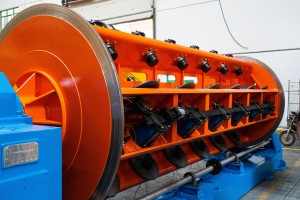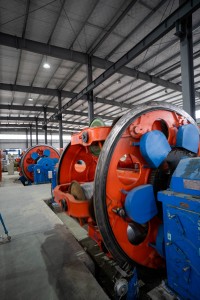Conductor stranding refers to stranding several single wires of the same diameter or different diameters together in a certain direction and according to certain rules to form a whole twisted core. Because it is not easy to bend and has poor flexibility when a single wire is used, it brings difficulties to production, transportation, installation, laying and use. Moreover, the cross-section of a single wire is large, and the eddy current loss is large, which affects the power transmission effect. The use of conductor stranding can effectively avoid these problems.
The composition of the conductor stranding machine is basically the same, except for the main machine, there are pay-off, traction, take-up, transmission system and control system.
1.Tubular Stranding Machine
The tubular stranding machine is a high-speed twisting machine, mainly used for the production of twisted or compacted copper strands, aluminum/aluminum alloy strands, steel strands, multiple strands, and insulated core stranding, etc.
During the twisting process of the tubular stranding machine, since the pay-off reel does not rotate, after the single wire is released from the pay-off reel, it passes through the guide wheel, the tube wall to the parallel mold, and as the pipe body rotates, the single wire does not wind around itself. The rotation of the axis of the tubular stranding machine does not produce single-wire twisting, so the twisting process of the tube stranding machine belongs to back-twisting stranding.
2.Rigid Frame Stranding Machine
The rigid frame stranding machine is a twisting machine without back twisting. Mainly used for stranded or compacted copper stranded wire, aluminum/aluminum alloy stranded wire, steel-cored aluminum stranded wire, and compact pre-twist of sector-shaped segmented conductors, etc.

The bobbins of the rigid frame stranding machine are divided into three or four frames in a vertical layout, and the bobbins are evenly distributed at 120° or 90° in the circumferential direction of the cage. The central shaft is not subject to the weight load of the wire reel, the radius of rotation of the winch cage is small, and its speed is double that of the cradle winch of the same specification, and the winch cage does not need supporting wheels, but is supported by large bearing seats at both ends, and the equipment has low noise.
3.Planetary Strander
The planetary strander is mainly used for the production of copper, aluminum/aluminum alloy stranded wire, multi-stranded wire, OPGW, and insulated core stranding, etc. The biggest advantage of the planetary strander is that it can realize 100% back-twisting. The most commonly used back-twist mechanism for planetary strander is the planetary gear back-twist mechanism, which can adjust the degree of back-twist.
From the perspective of stranding quality, compared with the tubular stranding machine, the single wire (or strand) of the planetary strander is directly led to the paralleling die, and the stress in the middle is small; the single wire (or strand) of the tubular stranding machine is guided along the tube body. There is a certain torsion force in the parallel mode, which will affect the original pitch of the strands when twisting the strands, and the quality is not as good as that produced by the cage stranding machine.
4.Skip Type Strander/ Bow Twister
The bow stranding machine is mainly used to produce stranded or compacted copper strands, aluminum/aluminum alloy strands, steel strands, multiple strands, and insulated core strands, etc. The working principle of the bow twister is similar to that of the tubular stranding machine, but the tube body is changed to a twisted bow, the weight of the equipment is lighter, and the rotation speed is higher.

